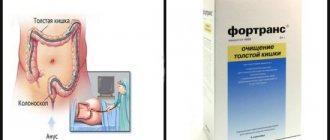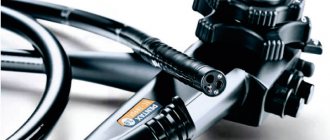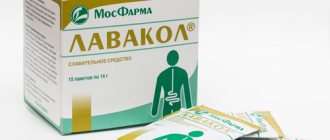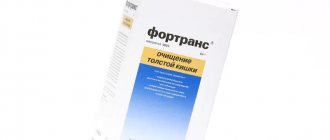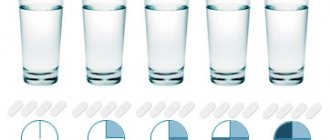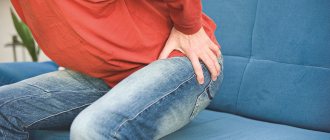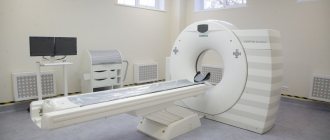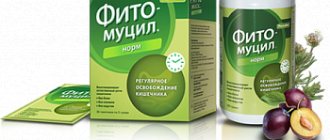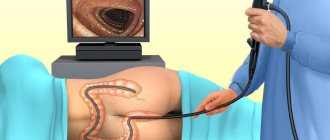the whole list
The presence of contraindications should be checked with a doctor.
If the preparation is carried out using the drug “Fortrans”, there is no need for cleansing enemas. 2 days before the colonoscopy, you need to switch to a special (slag-free) diet, excluding vegetables and fruits, potatoes, herbs, berries, mushrooms, legumes, and black bread from the diet. Allowed: broth, semolina porridge, egg, boiled meat, boiled sausage, fish, cheese, butter, fermented milk products, except cottage cheese.
It is advisable to start taking the Fortrans solution no earlier than 2 hours after eating. For effective preparation, you need to purchase 3 or 4 packages of the drug at the pharmacy. Four packages must be purchased for those patients who have a large body size, constipation, adhesive disease of the abdominal cavity, previously identified lengthening or prolapse of the colon (during the passage of barium through the intestines, irrigation or colonoscopy).
Composition of Fortrans
The active component is macrogol 4000. It is this ingredient in the drug that causes its laxative effect. Among the auxiliary components used in the production of Fortrans:
- sodium chloride (table salt);
- sodium bicarbonate (soda);
- sodium saccharinate;
- sodium sulfate anhydrous.
The medicine is available in the form of a powder packaged in paper bags, which must be dissolved before use. The weight of each sachet is 73.69 g, of which 64 g is macrogol, the rest is filled with auxiliary components.
The powder has a white color and a fine structure, due to which it dissolves almost instantly. There are 4 sachets in one package, their total cost is about 150 rubles. Fortrans is produced in France.
Mechanism of action of the drug
Fortrans is a laxative with osmotic action. Macrogol refers to polymer compounds with many intermolecular bonds. This structure of synthetic polyethylene glycol ensures the attraction of water and its retention, due to which macrogol quickly swells, greatly increasing the total volume of intestinal contents. As a result, intestinal peristalsis is activated, active contraction occurs and feces move towards the rectal sphincter, after which emptying occurs.
Features of the pharmacological mechanism of action of Fortrans include:
- The effect of the drug is only on the intestinal contents
. Once in the body, macrogol passes unchanged into the intestines, where it begins to attract water. The components of the laxative do not penetrate the bloodstream, which means they do not have a systemic effect on the body. - Using only the water needed to soften feces is what is in the intestines
. Due to this, Fortrans does not lead to dehydration. - Powerful cleansing effect
. The drug begins to act from the uppermost parts of the colon, that is, all accumulated toxins are completely removed from the digestive system. - Rapid development of laxative effect
. The first urge to defecate appears within an hour and a half after taking the first portion of the dissolved powder.
The auxiliary components contained in the drug maintain water and electrolyte balance and replenish the loss of fluid excreted in the stool.
Fortrans must be dissolved in the amount of water recommended by the manufacturer, this ensures the most pronounced laxative effect.
The medicinal components of the drug do not remain in the body and are released along with the contents of the intestine. The laxative effect after taking the last dose of Fortrans lasts for 2-6 hours.
Clinical experience with the use of the drug Fortrans for preparation for colonoscopy
Nikiforov P.A., Golubeva S.V., Blokhin A.F., Danko A.I., Kerin V.V., Burkov S.G.
Currently, the need for endoscopic examinations of the colon is constantly increasing. First of all, it is due to a fairly high incidence of colon cancer, which determines the need for preventive examination of large groups of the population, which, according to certain parameters, can be classified as high-risk groups. The capabilities of modern endoscopic equipment require a detailed examination of the colon and the use of special techniques for studying the mucous membrane, primarily in search of precancerous changes and initial forms of cancer. Thus, colonoscopy today, on the one hand, is a “routine” method of mass examination, and on the other, a unique and often definitive means of diagnosing a number of diseases [1].
The success of this procedure largely depends on the quality of preparation of the colon for examination. Currently, two main methods are used in practice: the prescription of laxatives followed by colon lavage through enemas and the lavage method. Due to a number of objective and subjective reasons (participation in the preparation of a second person, painful sensations, possible contraindications of a medical nature, negative attitude and psychological rejection by the patient himself and, most importantly, the rather frequent ineffectiveness of preparation), the use of enemas today has lost its leading role in preparation for colonoscopy and the lavage method is considered as the main one.
The essence of the lavage method is fundamentally reduced to the mechanical flushing of intestinal contents by ingesting a certain amount of liquid through the mouth, into which various components are introduced in order to keep it in the intestinal lumen and, if possible, to avoid water and electrolyte disturbances associated with the procedure. The attractiveness of the technique lies in its simplicity and the ability for the patient to independently, at home, prepare for the procedure, a small number of contraindications and, finally, the high probability of a full result under standard conditions of execution. Mannitol solution was previously used as a means for cleaning the intestines, the negative property of which is the excessive formation of gas, which is dangerous during electrosurgical manipulations. Abroad, a drug based on a sodium phosphate solution is quite widely used [9]. Recently, work has appeared in our country regarding the use of lactulose in preparation for colonoscopy. However, the information they contain does not yet allow us to make an unambiguous judgment about the capabilities of this drug [3,4].
One of the products widely used for cleaning the colon before colonoscopy is the drug Fortrans, produced by the pharmaceutical company, France. It is an isosmotic solution of polyethylene glycol (Macrogol 4000) and electrolytes. The Fortrans package, intended for one patient, consists of 4 packets containing 64 grams of polyethylene glycol in combination with 9 grams of electrolytes - sodium sulfate, sodium bicarbonate, sodium chloride and potassium chloride. Macrogol is a synthetic linear polymer (polyethylene glycol) that is not metabolized in the body, is not absorbed in the intestine and is capable of retaining water molecules, thereby increasing the volume of intestinal contents. Thanks to this, effective lavage is achieved when taking the drug orally, without the development of electrolyte disturbances, since the solution includes a complex of electrolytes, which makes it possible to obtain an isosmotic solution in combination with macrogol and thus maintain the water-electrolyte balance of the body.
Materials and research methods
In the medical institutions of the Medical Center, about 6,000 colonoscopies are performed per year. After testing and implementation into practice, Fortrans has become the means of choice in preparing patients for research over the past 4-5 years and is used in the vast majority of cases. The report examines the results of using the drug in 200 patients (92 men and 108 women) aged 18 to 82 years. 42% of patients were in hospital; 58% were examined on an outpatient basis. The sample is artificial; among the patients we included individuals who represent the main range of diseases and pathological changes in the colon that can be detected by endoscopy.
The indications for colonoscopy were:
- The patient has clinical signs of colon disease.
- Clarification of the diagnosis, differential diagnosis.
- Evaluation of therapy effectiveness.
- Endoscopic polypectomy.
- Clinical examination, clinical observation.
Among the pathological processes identified during endoscopy were malignant and benign tumors of the colon, inflammatory (including erosive and ulcerative lesions), diverticula, dystrophic and atrophic changes.
As the main or concomitant disease, in addition to those mentioned above, coronary heart disease without exacerbation, hypertension, peptic ulcer, diabetes mellitus, chronic obstructive pulmonary disease were noted. Contraindications to the study and use of the drug included severe heart and kidney failure, decompensation or exacerbation of the underlying disease, clinical signs of acute intestinal obstruction, and suspicion of an “acute abdomen.”
Method of taking the drug. 1 packet of Fortrans was dissolved in 1 liter of boiled water, which the patient drank within an hour - 1 glass every 15 minutes. We used two modes of administration. 37 patients took the first two liters of solution in the afternoon on the day before the colonoscopy, the second portion of 1.5-2 liters was taken in the morning on the day of the study. The remaining 163 patients took the entire dose within 4 hours in the afternoon preceding the colonoscopy. After the start of treatment, eating was prohibited. Our experience suggests the preference for dietary restrictions with the exclusion of toxins from the diet for 2-3 days preceding colonoscopy. To register possible side effects, dynamic observation was carried out taking into account patient complaints, hemodynamic parameters were assessed, as well as data from clinical and biochemical blood tests in 50 patients. Blood sampling was carried out 1-2 days before the start of preparation and after its completion on the day of colonoscopy.
Results of using the drug Fortrans
The effect of the drug, expressed in bowel movement (without previous pain and tenesmus), began 50-80 minutes after the start of administration and lasted 4-6 hours. Approximately 10% of patients also noted the release of light fluid in the morning on the day of the study. In the group where Fortrans was taken twice, bowel movement began within 20-30 minutes when taken again in the morning. The frequency of bowel movements ranged from 4 to 8-10. The end result was the release of a clear or slightly colored liquid.
In general, the drug was well tolerated by patients. As side effects associated with it, it should be noted a headache, which occurred in 6 patients 40-50 minutes after the start of preparation and went away on its own over the next 30 minutes. A fairly significant proportion of patients (27%) noted a feeling of fullness in the abdomen, 4% complained of nausea. Preparation was interrupted after ingestion of less than one liter of solution by three patients (1.5% of cases). 39 people (19%) for one reason or another reduced the dose of the drug to 2.5-3 liters. The laboratory test data assessed during the dynamic study, including hematocrit, total protein, creatinine, glucose and electrolytes (K, Ca, Na), did not undergo significant changes. Hemodynamic parameters remained stable.
Preparation was assessed as excellent or good if there was no contents at all or if there was a clear or turbid liquid that did not interfere with the examination and was easily aspirated. The preparation was considered satisfactory if fecal residues were found in the intestinal lumen or on the walls, which nevertheless made it possible to conduct the study. With poor preparation, a full examination of the entire intestine was impossible. Of the 200 patients, the entire colon was examined in 193 and the terminal ileum in some. The time required for the device to reach the dome of the cecum ranged from 10 to 30 minutes. In 7 patients, the study was completed when an occlusive tumor was detected in the sigmoid colon and splenic colon. angle and transverse section of the colon, which does not allow the device to be passed into the proximal sections. Complete absence of contents in the lumen (excellent preparation) occurred in 12 cases (6%). In 149 patients (78%) there was residual clear liquid in the intestinal lumen in the amount of 50-200 ml, which did not interfere with a full examination, which was freely removed using suction. With a short exposure between the completion of preparation and the beginning of endoscopy, the flow of clear fluid from the ileum into the cecum was noted. In patients with resected colon, residual fluid was noted in all observations. Its presence was more often noted in persons with evacuation disorders and habitual constipation. In 24 patients (12%) in certain parts of the intestine there were marks of feces on the walls or remains of liquid feces in the cecum, which did not interfere with the examination. In 8 (4%) patients, dense feces were present in the lower sections or cecum, which made it difficult to conduct a full examination. It should be said that among them there were mainly patients who took an incomplete dose of the drug. Thus, good and excellent preparation was achieved in 161 patients (84%). The use of Fortrans made it possible to clearly assess the local and diffuse changes present in patients. In addition to tumors, these included signs of inflammation and diverticula. In 22 patients, preparation with Fortrans preceded polypectomy. In all cases, the manipulation was successful, no complications were noted. In our observations, we did not note the appearance of artefactual changes in the mucosa associated with preparation. There were also no clinical or imaging signs indicating decompensation of the underlying disease (eg, occlusive tumor or ulcerative colitis).
The discussion of the results
The widespread use of colonoscopy requires the availability of effective means of preparation for the study in the doctor’s arsenal. The main requirements for it should be considered, first of all, the high specificity of the method, which makes it possible with a high degree of probability to achieve a guaranteed result in a wide range of patients, with a minimum number of side effects and contraindications. The method of cleansing the colon by taking laxatives and subsequent enemas is still dominant in our country (and is less and less used abroad as a mass means of preparation). Weaknesses of the technique: labor intensity, the need for special conditions in its implementation and the participation of medical personnel, a fairly wide range of restrictions relating to both the use of laxatives such as castor oil (intolerance, tenesmus, somatic contraindications) and the direct use of enemas. However, the most significant factor limiting the capabilities of the method is its relatively low efficiency - in 30-70% of cases the colon may be dirty, which requires repeated preparation and repeat colonoscopy, not to mention damage to the equipment and psychological costs for the patient [6] . The lavage cleaning method seems attractive primarily from the point of view of its “physiology”. Self-administration of the solution and natural bowel movement makes the procedure as accessible as possible, including preparation for the study at home. Fortrans is currently widely used as a lavage cleaning agent. The advantage of which is the presence in its composition of macrogol (polyethylene glycol) - an osmotic laxative, which “transits” through the intestinal tube without being metabolized or absorbed into it. An important component of the solution is the salt additive, which contains the most important electrolytes and ensures isosmolarity of the solution [5,6,7]. Among its specific advantages, in addition to those described above, we could include its effectiveness and safety in the preparation of patients whose colonoscopy revealed malignant tumors with a significant degree of obstruction. From the above, of course, it does not follow that the drug can be prescribed to persons who have already developed signs of intestinal obstruction. The second group of patients are patients with inflammatory bowel diseases (in our experience, excluding the most acute phase of the disease with severe somatic disorders or complicated forms). Fortrans can be quite widely used in this form of pathology as a means of preparation: due to its biological “inertness” it is more preferable in comparison with other methods.
25 years of global experience in the use of Fortrans or other drugs based on macrogol in medical practice has confirmed their unconditional effectiveness and preference in preparing patients for colonoscopy. Similar trends are emerging in our country, which is confirmed by our own experience. When choosing a method for cleaning the colon before endoscopic examination, it is necessary to remember that for a significant proportion of patients, colonoscopy is the final and final method in the diagnostic chain, providing guaranteed and high-quality preparation for the examination.
Literature 1. Nikiforov P.A., Bazarova M.A. A modern method of preparation for colonoscopy and endoscopic polypectomy. Abstracts of reports of the 5th Russian Gastroenterological Week. Russian Journal of Gastroenterology, Hepatology, Coloproctology No. 5 1999, page 64. 2. Nikiforov P.A., Vinogradova N.N., Anokhina L.N., Danko A.I., Nikitina S. A., Odintsov S.V., Guryev P.V. Possibilities of gastrointestinal endoscopy in the diagnosis of stomach and colon cancer in conditions of active medical examination “Kremlin Medicine” No. 1, 2000, pp. 57-60 3. Knyazev M.V., Korobkin S.V. Preparation of the colon for endoscopic examination with Duphalac. Clinical endoscopy No. 3, 2005, pp. 1-3 4. Poddubny B.K., Mashurov S.T., Karman S.N., Gubin A.N. Taking the drug Duphalac (lactulose) to prepare the colon for coclonoscopy in cancer patients. Clinical endoscopy, 2005, No. 2, pp. 29-31 5. Rej JF, Souquet JS Acceptability of the colonic preparation.The interest in fractioning Fortrans doses for a better preparation to colonoscopy/. Adaptet from Medecine et Chirurgi Digestives 1990.19№8. p/507-511 6. Davis GR, Santa Ana CA, Moranwski SG, Fordtran JS Development of the lavage solution associated with minimal water and elctrolyte absorption or secretion. Gastroenterology 1980,78,991-995 7. Delmotte JS Ph. Desurmont, Ph. Houcke, JC Use of a solution containing plyeitylene glycoli (colled Fortran”s solution) to prepare colon for endoscopy or sugery Ann. Gastroeterol. Hepatol., 1988, 24, No. 4, 211-216 8. Huann-Sheng Wang, Jen-Kou Lin. JA Randomizid prospective trial of bowel preparation for colonoscopy with Fortrans Compared with Bisacodyl.. of Chin. Med. Association, Vol. 66, No. 6, p. 364-368 9. Rey1, J. Delmotte2, D. Gorce3, J. Larpent3, S. Mathieu3, P. Garnier4, H. Mathiex-Fortunet4, J. Flejou5 EFFICACY AND SAFETY OF AN ORAL STANDARD ELECTROLYTES SOLUTION (FORTRANS®) COMPARED TO A SODIUM PHOSPHATE SOLUTION (FLEET® PHOSPHO-SODA) IN THE PREPARATION OF PATIENT FOR COLONOSCOPY. Citation: Endoscopy 2003; 35 (SUPPL II) A117 10. LAZARAKI G1, DOKAS1 SM, ChristodouLou1 K., Adamidou1 A., Kouklakis2 GS, ChristOFORIDIS1 C., Ziakas1 G. Randomized Tial of Two Classic Bowel Preparata Ion Schemas in Different Socoeconomic Status Populations Citation: Endoscopy 2004; 36 (Suppl I) A82A.
In what cases is it used?
Doctors primarily prescribe drinking Fortrans to cleanse the intestines during the period of preparation for diagnostic procedures, such as:
- irrigoscopy;
- colonoscopy;
- irrigography.
Complete cleansing of the large intestine improves the visualization of its location and pathological changes, which allows you to make the most accurate diagnosis. Fortrans is often prescribed instead of a cleansing enema before operations on the digestive and pelvic organs.
For constipation, Fortrans is not recommended to be used too often - maximum 2-3 times a year.
Frequent use of Fortrans for chronic or episodic problems with bowel movements can cause microflora disturbances, colitis and other digestive problems. The medicine can be used up to 3 times a year to cleanse the body in order to remove accumulated toxic compounds and toxins.
The procedure improves liver function, helps cleanse the skin, and has a positive effect on digestion.
General admission rules
The medicine is intended for oral administration. Before use, the powder is diluted in water - one liter of clean water is needed for each packet of powder. The dosage is calculated based on weight - for every 15-20 kilograms, 1 packet of Fortrans is required. Thus, an average weight adult (70 kg) may need 3-4 sachets to cleanse the intestines. Rules of use:
- The entire required volume of Fortrans should be dissolved in the required volume of water. That is, for 4 bags you will need to take 4 liters of boiled water.
- The drug should be taken 2 hours after dinner. It is also recommended to review the timing of taking the medications used; their evening dose should also be taken no later than 2 hours before cleansing.
- The entire prepared solution should be drunk during the evening. The rate of its intake is 1 liter over one hour.
- Fortrans is drunk in small sips in a glass. The break between drinking a glass of laxative solution should be 10-15 minutes.
The total dose of the medicine can be divided into 2 times, half taken in the evening and the other in the morning. But this option of using a laxative is allowed only if the study or surgical intervention is scheduled for the daytime or evening hours.
Fortrans begins to act in most cases within an hour and a half and the laxative effect after taking the last portion lasts up to 3, less often 4-5 hours.
Due to the rapid and long-lasting laxative effect, it is better to start using this medication no later than 18:00 in the evening. In this case, complete cleansing of the intestines can be achieved before 11-12 am.
General rules for using Fortrans
The drug can be taken orally by adults and children over 15 years of age. Fortrans should be taken no earlier than two hours after meals.
The dosage of Fortrans is calculated individually depending on body weight, and is rounded up to the whole sachet. The dose is calculated based on the ratio of 1 sachet per 15–20 kg of weight.
For example, a person weighs 70 kg, which means that he will need 70 kg / 15 kg = 4.67 sachets or 70 kg / 20 kg = 3.5 sachets to perform intestinal lavage. In both cases, the result is a fractional number that must be rounded up to a whole number. That is, 4.67 is rounded up and you get 5 bags. And 3.5 is rounded up to whole numbers and you get 4 bags. This means that for a person weighing 70 kg, 4–5 sachets of Fortrans are needed to carry out the lavage procedure.
How many specific sachets should be used for the procedure is determined by the doctor who prescribed Fortrans. However, at present, most often the calculation is based on the ratio of 1 sachet for every 20 kg of body weight. Practitioners have found that the ratio of 1 sachet per 20 kg of weight is subjectively better tolerated, but provides the same effect as 1 sachet per 15 kg of weight. Therefore, the patient is offered the lowest effective dosage.
Having calculated the required number of bags, it is necessary to prepare clean, boiled water in sufficient quantity. For 1 sachet of Fortrans powder you will need 1 liter of water. All powder should be dissolved in the required amount of water, for example, 2 sachets in two liters of water, 3 sachets in 3 liters, etc. To avoid confusion, it is recommended to dissolve each packet of powder in a separate jar or any other container.
The entire prepared solution should be taken at one time. However, this does not mean that you need to drink all 3 - 4 liters of solution in one go. It is recommended to pour the solution into a glass and drink it in small sips. Drink the next glass in 5 – 10 minutes, etc. Thus, taking breaks between glasses of the solution for 10 - 20 minutes, you need to drink the entire prepared volume of Fortrans. On average, this can take from 2 to 4 hours. The intake rate of Fortrans should be approximately 1 liter per hour.
If it is not possible to drink the entire solution at one time, then you can divide it into two equal portions, one taken in the evening and the second in the morning. For example, drink 2 liters in the evening, and another 2 liters in the morning of the next day.
Since the solution can cause a gag reflex due to a subjectively unpleasant taste, it is recommended to drink it in quick small sips without holding it in the mouth. And immediately after the last sip from the next glass, it is recommended to put a piece of lemon in your mouth or take a sip of lemon juice, which will immediately relieve the gag reflex and eliminate nausea.
Since after the last dose of Fortrans, defecation may continue for another 2 to 3 hours, it is recommended to calculate the time of use of the drug. It is best to take Fortrans in the evening, on the eve of the upcoming examination in the morning. If the study will be carried out in the afternoon or evening, then you can drink Fortrans in the morning, but the last glass should be taken 3 - 4 hours before the procedure.
Stool begins to be released approximately 1.5 - 2 hours after the first glass of Fortrans. At this point, the entire volume of the solution may not have been drunk yet. In this case, you should continue to drink the Fortrans solution in glasses until the entire prepared volume has been taken. Doctors usually recommend taking another glass of Fortrans after each bowel movement.
An overdose of Fortrans is impossible, since the drug is not absorbed into the bloodstream and is excreted unchanged. When Fortrans is taken simultaneously with other medicinal substances, their effect is significantly weakened.
Fortrans – preparation for colonoscopy or irrigoscopy
Proctologists, radiologists and endoscopists believe that it is better to cleanse the intestines with Fortrans not on the eve of the upcoming procedure, but directly on the day on which it is planned. However, to do this you will have to get up early in the morning, at about 5:00, if the procedure is scheduled for 10:00. So, the evening before irrigoscopy and colonoscopy, you should prepare the required amount of water, bags of Fortrans powder and lemons. In the morning, you need to dilute the powder in water and drink the solution within 2 - 3 hours - from approximately 5-00 to 8-00 am. It is recommended to drink one glass of the solution every 5 to 15 minutes.
The first portion of stool will be released 1 - 2 hours after starting to take Fortrans, and will end 2 - 3 hours after taking the last glass of the laxative drug. 4 hours after taking the last glass of Fortrans, you can perform irrigoscopy or colonoscopy.
However, if the irrigoscopy or colonoscopy procedure is scheduled for earlier hours, for example, at 7-00, 8-00 or 9-00 in the morning, then it is recommended to cleanse the intestines with Fortrans the night before. In this case, it is optimal to start taking Fortrans at 17:00 or 18:00 in the evening and finish by 20:00 or 21:00.
How long does it take for Fortrans to work?
The first portion of stool is released 1 to 2 hours after taking the first glass of Fortrans solution. That is, we can say that the drug begins to act 1 – 2 hours after administration.
Duration of action of Fortrans
After taking the last glass of Fortrans solution, stool excretion may continue for 2 to 4 hours, depending on the individual characteristics of the human body. This means that in total Fortrans lasts approximately 6 – 8 hours, depending on the amount of solution drunk.
special instructions
Fortrans is considered one of the most powerful laxatives. To ensure that the drug does not have a negative effect and does not worsen your well-being, it must be taken correctly:
- It is imperative to accurately calculate the dosage of the medicine. To do this you need to know your weight.
- After starting to take a laxative, you should not eat. But you can and should drink - filtered water, tea, compote.
- Dissolved Fortrans has a not very pleasant taste, which causes nausea and vomiting in many people. To reduce their severity, you should drink the medicine in small sips, and after taking it, dissolve a slice of lemon or orange in your mouth, wash down the medicine with plain or acidified water.
- The day after cleansing, it is advisable to follow a rice diet. Eating rice has a strengthening effect and thus prevents the development of diarrhea.
Some doctors recommend taking probiotics for 7-10 days after taking the medication. Their use will eliminate the risk of developing dysbiosis and improve the restoration of normal intestinal function. Medicines from this group are especially necessary for people with chronic diseases of the digestive system.
After starting to use Fortrans, it is not advisable to go outside, since defecation can happen at the most inopportune moment.
Preparation for intestinal irrigoscopy with Fortrans begins 2-3 days before the procedure and involves following a special laxative diet.
The patient is asked to exclude heavy foods from the diet, that is, brown bread, potatoes, legumes, meat and fatty foods.
They need to be replaced with vegetable and lactic acid foods, light vegetable soups, and water porridge. On the day of taking Fortrans, the last meal should be no later than 3 o’clock in the afternoon, then from 17-18 o’clock in the evening you can start drinking the dissolved powder.
Preparation for examinations under anesthesia with FORTRANS
Share information with your Facebook friends
VK
The examination under sedation or anesthesia must be done strictly on an empty stomach. You cannot even drink water later than 3 hours before the test.
Preparing for a colonoscopy
Preparation for colonoscopy (intestinal endoscopy) includes 3 stages: following a diet, choosing a nutrition plan depending on the time of intestinal endoscopy, and the process of bowel cleansing itself.
If you have chosen the drug FORTRANS
Each liter of drug solution takes an average of 2 hours to act. While taking the drug, it is recommended to perform light physical exercises: circular rotations of the pelvis, bending to the sides, forward, backward, squats. You can do some light house cleaning: dusting, vacuuming, vacuuming, tidying up your closet.
The criteria for a patient's readiness for intestinal endoscopy are the appearance of liquid that is clear or slightly yellow in color.
The appropriate time frame for traveling to the clinic for a colonoscopy must be considered. If it is possible to undergo training at a clinic, find out about it in advance. Some patients find it easier to undergo it under the supervision of medical staff.
Stage 1. Diet.
Forbidden
1-2 days before colonoscopy.
All plant foods: vegetables and fruits, berries, herbs, cereals and cereals, nuts, bread. Colored juices, alcohol, carbonated drinks and everything that is not included in the “allowed” section.
Allowed
1-2 days before colonoscopy.
All protein foods: boiled meat and poultry with the exception of sausages, low-fat fish, low-fat fermented milk products, cottage cheese, eggs. Low-fat clear broth, weak black tea without milk, compote without berries, clarified juice without pulp, non-alcoholic, uncolored clear drinks, water.
Stage 2. Colonoscopy time.
Colonoscopy in the morning (before lunch)
If intestinal endoscopy is scheduled between 8:00-10:00. Recommendations: the day before the colonoscopy, before 9:00, breakfast according to the list of allowed foods. Lunch and dinner - only permitted liquids.
If intestinal endoscopy is scheduled between
10:00 and 14:00.
Recommendations: the day before the colonoscopy, before 13:00, breakfast and lunch according to the list of allowed foods. Dinner - only permitted liquids.
Colonoscopy in the evening (after lunch)
If intestinal endoscopy is scheduled between 14:00 - 19:00. Recommendations: the day before the colonoscopy, breakfast, lunch and dinner until 16:00 according to the list of permitted foods. On the day of colonoscopy, from morning to 12:00 - only permitted liquids.
Stage 3. Taking the drug
To date, the recommendation of all European and American endoscopic communities is ONLY two-day separate (split) preparation.
1 day before colonoscopy.
On this day, the preparation is the same, both for colonoscopy in the morning and in the evening.
From 18:00-20:00, take 2 liters of liquid:
Having previously dissolved two identical sachets of Fortrans in 2 liters of water. Each liter is drunk gradually, over an hour. Every 10 minutes, take a glass, not in one gulp.
Day 2. On the day of the colonoscopy:
5 hours before the start of the study, take 2 liters of liquid, having previously dissolved two identical Fortrans sachets in 2 liters of water, depending on the time of your colonoscopy (see table).
| Time of your colonoscopy | Time to take 2 liters of the drug on the day of colonoscopy |
| 8.00 | 3.00-5.00 |
| 9.00 | 4.00-6.00 |
| 10.00 | 5.00-7.00 |
| 11.00 | 6.00-8.00 |
| 12.00 | 7.00-9.00 |
| 13.00 | 8.00-10.00 |
| 14.00 | 9.00-11.00 |
| 15.00 | 10.00-12.00 |
| 16.00 | 11.00-13.00 |
| 17.00 | 12.00-14.00 |
| 18.00 | 13.00-15.00 |
| 19.00 | 14.00-16.00 |
Little tricks (for Fortrans):
- To improve the taste of the solution, you can cool it by placing it in the refrigerator the evening before the test.
- To improve the taste of the solution, you can dilute 1 packet with 900 ml of water + 100 ml of freshly squeezed orange or lemon juice without pulp and zest.
- It is recommended to drink clean water no later than three hours before the procedure. After this you can no longer drink anything.
- Drink one glass every 15-20 minutes until you drink the entire recommended amount.
You can take a break every hour during this process. And it is advisable to distract yourself with some household chores.
NOTE!
The drug of choice for preparing for colonoscopy is FORTRANS.
If:
- the patient is taking drugs from the group of angiotensin-converting enzyme inhibitors (Ace Inhibitor, Akf-Inhibitor), such as Convertin, Captopril, Capoten;
- drugs of the angiotensin receptor blocker group, such as Atacand, Oksaar
; - renal failure;
- heart failure;
- diabetes;
- symptoms that suggest nonspecific diseases of the large intestine (Crohn's disease, UC).
NOTE!
- If the patient is taking anti-clotting drugs such as Aspirin, Cardiomagnyl, Plavix
or
NSAIDs
. In this case, he is at risk of bleeding, although small. Therefore, the possibility of interrupting this treatment should be discussed. However, if taking these drugs is necessary (for example, if the patient has had a stroke or if a cardiac stent has been inserted within the last 6 months), it is recommended to consult a cardiologist or neurologist or blood clotting clinic regarding the risk associated with interruption in treatment.
If these medications are used only as a preventive measure, you are advised to stop taking them about a week before the procedure.
- Patients taking Coumadin
are at high risk of increased bleeding if a biopsy is performed and a polyp is removed during the procedure.
Therefore, it is recommended to interrupt treatment with this drug about a week before the procedure and consider replacing it with Clexane
.
In this case, a blood test (clotting study) should be done the day before the procedure. It is also necessary to stop taking Clexane
approximately 12-24 hours before the procedure. - Patients taking oral iron supplements (Venofer
|
Maltofer FOL
|
Totema
|
Ferlatum
|
Fenyuls
|
Ferinject
|
Ferroceron | Ferroplex | Ferronal | Ferrocal | Conferon | Tardiferon | Sorbifer)
to compensate for anemia should discontinue these medications 3 days before the procedure.
print version
TagsHealth research cleansing fortrans
Fortrans for weight loss
Laxatives are often used as weight loss aids. Fortrans really promotes weight loss; just taking a single dose, calculated based on body weight, helps to remove an extra 2-3 kilograms. However, such weight loss is due only to the release of accumulated feces and excess fluid from the body. Thus, Fortrans does not affect the reduction of fat in problem areas.
Long-term, that is, daily use of the drug is extremely dangerous. This method of losing weight leads to the fact that the body begins to experience a deficiency of vitamins and microelements, which has an extremely adverse effect on the functioning of internal organs, leads to weakness, apathy, and provokes hair loss, dry skin and other health problems.
However, Fortrans can be used in preparation for weight loss. The medicine is used as a means to cleanse the intestines, which greatly improves metabolic processes and makes it easier to follow a diet for weight loss. The peculiarities of taking a laxative in this case are no different from the recommendations that must be followed when using it before diagnostic procedures and operations.
How to take Fortrans before a colonoscopy
Fortrans is one of the most famous laxatives in Russia, with which you can qualitatively prepare the intestines for colonoscopy. This is a French drug, patients turn to it if the colonoscopy procedure is scheduled in the morning or evening. Colonoscopy is an examination of the lining of the large intestine, so it is very important that the intestinal wall is clean. In this article we will focus on the most popular remedy, which is used both in hospitals and at home, we will tell you how to take Fortrans correctly before a colonoscopy, and whether there is a difference in preparing for the study depending on when the procedure is scheduled - in the morning or in the evening.
Preparing for a colonoscopy examination using Fortrans
Fortrans can be easily purchased at a pharmacy. The medicine is sold in packages in powder form (1 package contains 4 powders). It has a peculiar fruity taste. The drug is not absorbed when consumed, since it is based on Macrogol. It acts only in the intestine, stimulating the contraction of its walls, and is easily excreted from the body, promoting the rapid evacuation of intestinal contents.
Before starting to take Fortrans, it is advisable to sit on a slag-free diet for 2-3 days, which involves excluding foods that cause flatulence (legumes, greens, vegetables, fruits, fatty and fried foods). We talk in detail about the slag-free diet in a separate article.
How to calculate and how to drink Fortrans before a colonoscopy
The medicine packet is diluted in 1 liter of warm boiled water and mixed thoroughly. The calculation is made as follows. For 15-20 kg of body weight, take 1 liter of water. Or you can use the diagram:
- up to 50 kg – take 2 sachets (2 liters of water),
- from 50 to 80 kg – 3 sachets (3 liters of water),
- more than 80 kg - 4 sachets (if weight is more than 100 kg, consult your doctor).
The approximate volume of liquid that a person of average weight should drink is 3-4 liters. The entire prepared solution must be drunk within 12-14 hours. The last portion should be drunk 5-6 hours before the test.
How to take Fortrans correctly before a colonoscopy?
The medicine can be taken on the day of the examination. By this day, the patient will have already prepared the intestines for taking Fortrans with the help of a slag-free diet. In the evening of the previous day, it is advisable not to eat after dinner, but you can drink as much as you like (but not alcohol or sparkling water). On the day of manipulation, you should also not eat; you can only drink water or weak tea. The entire volume of liquid with the dissolved medicine should be drunk between 5 and 10 am. Every 15-20 minutes you need to drink 200-250 ml of solution. Defecation begins 60-90 minutes after the first drink and ends 2-3 hours after taking the last glass. Therefore, examination is possible only 4 hours after taking the last portion. You can't eat anything on this day. Fluid intake is not limited. Remember that you must stay at home while taking a laxative. You should not plan any activities on this day.
Preparation for colonoscopy with Fortrans, if the procedure is in the morning.
If a colonoscopy is scheduled in the morning, it is better to prepare in 2 stages. Pre-calculate the amount of liquid and leave 1 packet (1 liter) for the morning. The day before at 16-17 o'clock the first glass is drunk, the last glass at 20 o'clock. Remember that bowel movements end 2 hours after the last medication. In the morning on the day of the study, you need to drink another liter. You must calculate what time to drink yourself, understanding that after taking the medicine you need to stay at home for 2 hours (you will be bothered by the urge to defecate). The examination should be no earlier than 4 hours after the last dose of Fortrans.
Advantages of Fortrans
- The medicine does not affect the mucous membrane.
- An electrolyte solution helps maintain water-salt balance in the body.
- More pleasant taste compared to, for example, Lavacol.
- There is no need to resort to enemas.
- There is no need to ask for outside help, as is the case with administering an enema.
Disadvantages of Fortrans.
- It has a specific fruity taste that not everyone can tolerate.
- There may be nausea and vomiting.
- You need to drink a large volume of liquid, and not all patients are able to drink a lot of solution.
- Fortrans is prescribed to patients over 15 years of age
Recently, in preparation for colonoscopy, the new generation laxative drug “Flit” has become more often used. It has practically no disadvantages and a lot of advantages compared to Fortrans.
If the preparation with Fortrans was carried out correctly, then the last bowel movement will be “clean” water, that is, there will be no feces in the intestines. This means that the endoscopist will be able to examine the colon mucosa carefully and make an accurate diagnosis.
Contraindications and side effects
Undesirable changes in well-being due to the use of Fortrans in the form of nausea and a tendency to vomit occur in almost everyone and are due to the specific taste of the solution. As a rule, they are usually pronounced in the first hour of taking the medicine, then decrease significantly. Other possible adverse reactions to Fortrans include:
- allergic reactions in the form of rashes on the body, swelling, urticaria;
- increased gas formation;
- heaviness in the stomach;
- weakness.
In rare cases, symptoms of anaphylactic shock are recorded. In the first two days after taking it, loose stools may bother you; a rice diet helps speed up the restoration of intestinal functions.
Absolute contraindications to taking Fortrans:
- severe dehydration;
- malignant tumors of the rectum;
- intestinal obstruction;
- erosive and ulcerative pathologies of the gastrointestinal tract;
- perforation of the stomach and intestines;
- hypersensitivity to polyethylene glycol;
- age up to 15 years;
- severe heart and kidney diseases.
- abdominal pain of unknown etiology.
The use of Fortrans during pregnancy is not recommended, as increased intestinal motility can increase the tone of the uterus. It is not advisable to use the drug while breastfeeding - dehydration can lead to disruption of breast milk production.
